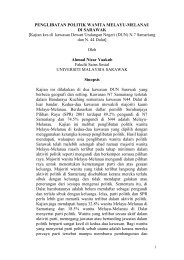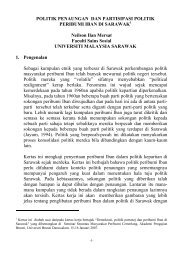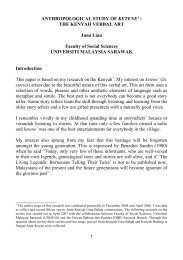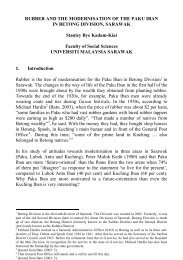OF SOUKHUAN AND LAOS Elena Gregoria Chai Chin Fern Faculty ...
OF SOUKHUAN AND LAOS Elena Gregoria Chai Chin Fern Faculty ...
OF SOUKHUAN AND LAOS Elena Gregoria Chai Chin Fern Faculty ...
Create successful ePaper yourself
Turn your PDF publications into a flip-book with our unique Google optimized e-Paper software.
Spiritual beings are held to affect or control the events of the material world, and<br />
man’s life here and after. It is also believed that they hold intercourse with men, and<br />
receive pleasure or displeasure from human actions. The belief in their existence lead<br />
naturally sooner or later to active reverence and propitiation. Thus animism in its full<br />
development, includes the belief in souls and in a future state, in controlling deities<br />
and subordinate spirits.<br />
Malinowski added that “the real nucleus of animism lies in the deepest emotional fact<br />
of human nature, the desire of life” (1948:81). This, Heinze said, goes back to<br />
psychology and she specially referred to Freud’s thought (1938) as follows, “Human<br />
beings have souls which can leave their habitation and enter into other beings; these<br />
souls are the bearers of spiritual activities and are, to a certain extent, independent of<br />
the ‘bodies’. Originally, souls were thought of as being very similar to individuals;<br />
only in the course of a long evolution did they lose their material character and<br />
attained a high degree of ‘spiritualization’ (1938:866). Animism is a system of<br />
thought which gives an explanation of a single phenomenon, but makes it possible to<br />
comprehend the totality of the world, as a continuity. It is said that in the course of<br />
time, three such systems of thoughts came into being; the animistic (mythological), the<br />
religious, and the scientific.<br />
The soukhuan is largely in connection with the human soul, often affecting one’s well<br />
being and health. The accounts of events observed in this research has a strong<br />
resemblance to the ideas of animism as described above. The animistic and religious<br />
beliefs of the people practicing soukhuan are widely discussed here, very often<br />
without a clear scientific explanation of why such event is performed or held.<br />
Heinze noted that animism is the first conception of the world which man succeeded<br />
in evolving and was therefore psychological. It did not require any science to establish<br />
it, for science sets in only after we have realized that we do not know the world and<br />
that we must therefore seek means of getting to know it. Animism was natural and<br />
self-evident. We are therefore prepared to find that primitive man has transferred the<br />
structural relations of his own psyche to the outer world. On the other hand, we may<br />
make attempts to transfer back to the human soul, what animism teaches about the<br />
nature of things (1938:867, 877-78). Heinze provided a coherent definition of<br />
animism, which can be understood in the context of soukhuan. Nevertheless, in the<br />
following discussions, the soukhuan is portrayed as an identity bearer. Rather than<br />
analyzing in detail the true relevancy of animistic definitions as described above with<br />
the subsequent accounts of event, I will discuss soukhuan in the context of Laos<br />
nationality.<br />
A brief history of religious practices in Laos<br />
Animism with ancestor-worship is the traditional belief of the Laos people. It formed<br />
the first layer of Laos religion. When Buddhism spread from Sri Lanka to Laos in the<br />
- 3 -<br />
PDF Creator - PDF4Free v2.0<br />
http://www.pdf4free.com







